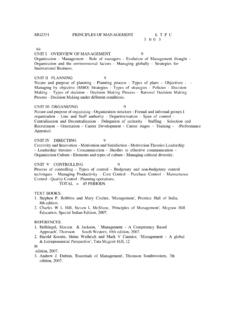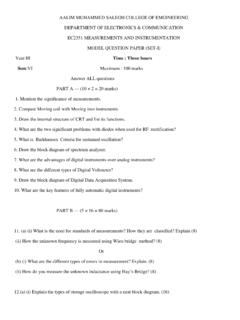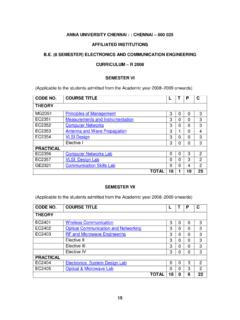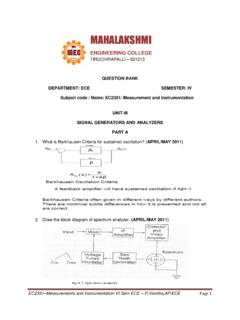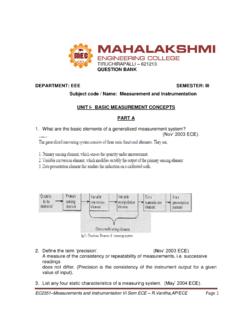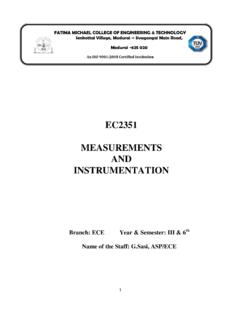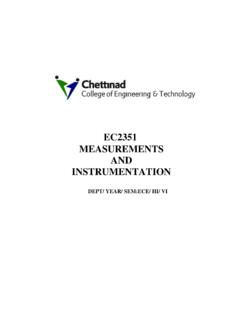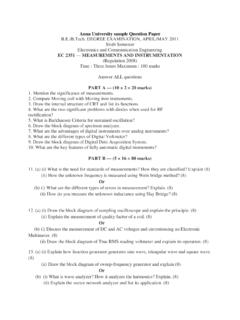Transcription of ROEVER ENGINEERING COLLEGE - Perambalur, Tamilnadu, India
1 ROEVER ENGINEERING COLLEGE ELAMBALUR PERAMBALUR 621 212, Subject Code : ec2351 Subject Name : MEASUREMENTS AND instrumentation Department : ECE Year/ Semester : III/ VI PREPARED By & ASSISTANT PROFESSOR/ ECE ec2351 MEASUREMENTS AND instrumentation UNIT I BASIC measurement CONCEPTS measurement systems Static and dynamic characteristics Units and standards of measurements Error analysis Moving coil, moving iron meters Multimeters True RMS meters Bridge measurements Maxwell Hay Schering Anderson and Wien Bridge. UNIT II BASIC ELECTRONIC MEASUREMENTS Electronic multimeters Cathode ray oscilloscopes block schematic applications special oscilloscopes : delayed time base oscilloscopes, analog and digital storage oscilloscope, sampling oscilloscope Q meters Vector meters RF voltage and power measurements True RMS meters.
2 UNIT III SIGNAL GENERATORS AND ANALYZERS Function generators RF signal generators Sweep generators Frequency synthesizer Wave analyzer Harmonic distortion analyzer Spectrum analyzer. digital spectrum analyzer, Vector Network Analyzer Digital L,C,R measurements, Digital RLC meters UNIT IV DIGITAL INSTRUMENTS Comparison of analog and digital techniques digital voltmeter multimeters frequency counters measurement of frequency and time interval extension of frequency range Automation in digital instruments, Automatic polarity indication, automatic ranging, automatic zeroing, fully automatic digital instruments, Computer controlled test systems, Virtual instruments. UNIT V DATA ACQUISITION SYSTEMS AND FIBER OPTIC MEASUREMENTS Elements of a digital data acquisition system Interfacing of transducers Multiplexing Computer controlled instrumentation IEEE 488 bus Fiber optic measurements for power and system loss Optical time domains reflectometer.
3 TEXT BOOK 1. Albert D. Helfrick, and William D. Cooper, Modern Electronic instrumentation and measurement Techniques , PHI, 2003. REFERENCES 1. Joseph J. Carr, Elements of Electronics instrumentation and measurement , Pearson education, 2003. 2. Alan. S. Morris, Principles of Measurements and instrumentation , 2nd Edition, PHI, 2003. 3. Ernest O. Doebelin, measurement Systems Application and Design , TMH, 2004. UNIT I BASIC measurement CONCEPTS measurement systems Static and dynamic characteristics Units and standards of measurements Error analysis Moving coil, moving iron meters Multimeters True RMS meters Bridge measurements Maxwell Hay Schering Anderson and Wien Bridge. PART-A 1.
4 What is meant by measurement ? measurement is an act or the result of comparison between the quantity and a predefined standard. 2. How are instruments classified? Mechanical Instruments Electrical Instruments and Electronic Instruments. 3. Define static error. Difference between the measured and true value 4. Define accuracy. Accuracy may be defined as the ability of a device to respond to a true value of a measured variable. 5. Define sensitivity. It is the ratio of a change in output to the change in input 6. What is dead zone? It is defined as the largest change of input quantity for which there is no output of the instrument 7. What is precision? Precision is the degree of exactness for which an instrument is designed or intended to perform.
5 8. What is instrument error? Instrument error refers to the combined accuracy and precision of a measuring instrumentthe difference between the actual value and the value indicated by the instrument (error). 9. Define Calibration. It is the process by which comparing the instrument with a standard to correct the accuracy. 10. What are random errors? Random error unlike systematic error is not unidirectional. Some of the measured values are greater than true value; some are less than true value. The errors introduced are sometimes positive and sometimes negative with respect to true value. It is possible to minimize this type of error by repeating measurements and applying statistical technique to get closer value to the true value.
6 11. Define systematic error. A systematic error results due to faulty measurement practices. The error of this category is characterized by deviation in one direction from the true value. What it means that the error is introduced, which is either less than or greater than the true value. Systematic error impacts the accuracy of measurement not the precision of the measurement . 12. What are the Methods of measurement ? Direct method Unknown quantity (Measurand) is directly compared against a standard Common for the measurement of physical quantity like length, mass and time Indirect method 13. Explain the function of measurement system. The measurement system consists of a transducing element which converts the quantity to be measured in an analogous form.
7 The analogous signal is then processed by some intermediate means and is then fed to the end device which presents the results of the measurement . 14. Define Instrument. Instrument is defined as a device for determining the value or magnitude of a quantity or variable. 15. List the types of instruments. The 3 types of instruments are Mechanical Instruments Electrical Instruments and Electronic Instruments. 16. Classify instruments based on their functions. 1. Indicating instruments 2. Integrating instruments 3. Recording instruments 17. Give the applications of measurement systems. The instruments and measurement systems are sued for Monitoring of processes and operations. Control of processes and operations. Experimental ENGINEERING analysis.
8 18. Why calibration of instrument is important? The calibration of all instruments is important since it affords the opportunity to check the instrument against a known standard and subsequently to errors in accuracy. PART - B (16 MARK QUESTIONS) 1. Discuss different type of Standards of measurement . Classify and explain the different type of Standards of measurement for bust/waist/hip measurement . measurement is the process or the result of determining the magnitude of a quantity, such as length or mass, relative to a unit of measurement , such as a meter or a kilogram. The word measurement stems, via the Middle French term mesure, from Latin m ns ra, and the verb metiri. Metrology is the science of measurement .
9 With the exception of a few seemingly fundamental quantum constants, units of measurement are essentially arbitrary; in other words, people make them up and then agree to use them. Nothing inherent in nature dictates that an inch has to be a certain length, or that a mile is a better measure of distance than a kilometre. Over the course of human history, however, first for convenience and then for necessity, standards of measurement evolved so that communities would have certain common benchmarks. Laws regulating measurement were originally developed to prevent fraud in commerce. Today, units of measurement are generally defined on a scientific basis, overseen by governmental or supra-governmental agencies, and established in international treaties, pre-eminent of which is the General Conference on Weights and Measures (CGPM), established in 1875 by the Treaty of the metre and which oversees the International System of Units (SI) and which has custody of the International Prototype Kilogram.
10 The metre, for example, was redefined in 1983 by the CGPM as the distance traveled by light in free space in 1 299,792,458 of a second while in 1960 the international yard was defined by the governments of the United States, United Kingdom, Australia and South Africa as being exactly metres. Imperial system Before SI units were widely adopted around the world, the British systems of English units and later imperial units were used in Britain, the Commonwealth and the United States. The system came to be known as customary units in the United States and is still in use there and in a few Caribbean countries. These various systems of measurement have at times been called foot-pound-second systems after the Imperial units for length, weight and time even though the tons, hundredweights, gallons, and nautical miles, for example, are different for the units.
